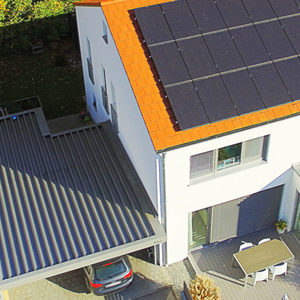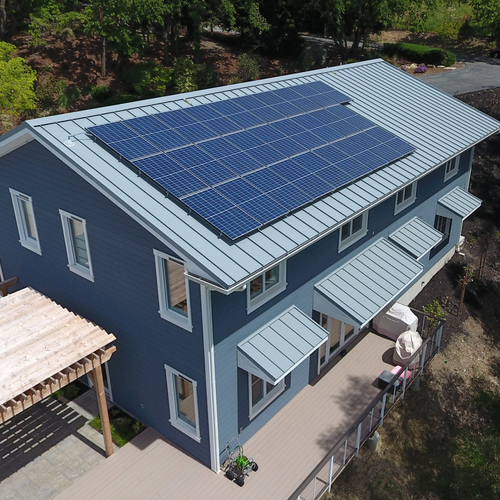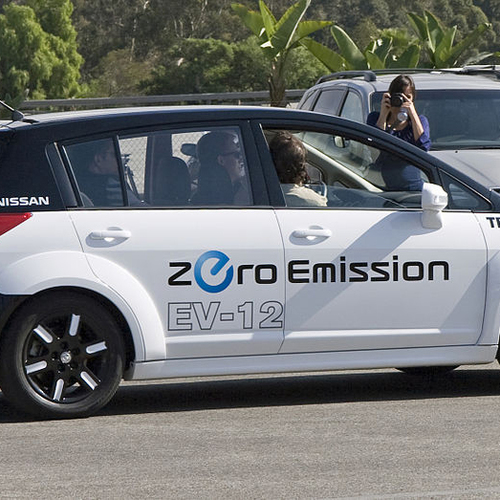Image Credit: Image #1: Martin Holladay
Image Credit: Image #1: Martin Holladay Look at the green line. Wind power generation is volatile and not always in sync with the actual demand for power (red line, below the blue).
Image Credit: Image #2: Bonneville Power Administration
As more wind and solar energy comes online, the people who run the power grid have a problem: how do they compensate for the variable nature of the sun and wind?
California plans to spend billions of dollars for batteries to even out the flow of power from solar and wind, much the way shock absorbers smooth out bumps on the road. But do they need to? Not at all!
In my research, I’ve found that we can accommodate a grid powered 50 percent by renewable energy without the use of batteries.
Systems flexible enough to accommodate the ups and downs of solar and wind production can be made by adjusting the power at millions of homes and businesses on a minute-by-minute or even second-by-second basis. This approach requires no new hardware, some control software, and a bit of consumer engagement.
Massive balancing act
Already, electric power procured from the wind or sun is leading to large and small “bumps” in the energy fed to the grid.
For example, on a typical week in the Pacific Northwest, power can increase or decrease by more than one gigawatt in an hour. That’s the equivalent of the output from one huge nuclear power plant able to supply a million homes.
This is an enormous challenge to grid operators in this region. Massive fluctuations in power require equally massive storage devices that can charge when the wind is blowing, and discharge during periods of calm.
Now, the balance of supply and demand for power is primarily done by generating more power rather than storage.
Grid operators draw on what is called the balancing reserves obtained from fossil fuel generators or hydro plants, when available. These power plants ramp up and down their output in response to a signal from a grid balancing authority. This is just one of many ancillary services required to maintain a reliable grid.
Many states are now scrambling to find new sources of ancillary services, and the federal government is also searching for incentives: Federal Energy Regulatory Commission (FERC) orders 745, 755, and 784 are recent responses by a government agency to create financial incentives for responsive resources to balance the grid.
Are batteries the solution?
Storage is everywhere, but we have to think beyond electricity.
Consider a large office building. Will anyone notice if the fan power is reduced or increased by 10 percent for 10 or 15 minutes? This makes no demands on the comfort of occupants of the building, but the resulting deviations in power can provide a substantial portion of the needs of the grid. A building can be regarded as a virtual battery because of thermal inertia — a form of thermal storage.
What about for longer time periods? Residential pool pumps (as well as pumps used in irrigation) are a significant load in Florida and California — well over one gigawatt in each state — that can be run at different times of the day.
Through local intelligence — in the form of a chip on each device or a home computer for many devices — the collection of one million pools in Florida can be harnessed as massive batteries. Through one-way communication, each pool will receive a regulation signal from the grid operator. The pool will change state from on to off based on its own requirements, such as recent cleaning hours, along with the needs of the grid. Just as in the office building, each consumer will be assured of desired service.
Pools are, of course, just one example of a hungry but flexible load.
On-off loads such as water pumps, refrigerators, or water heaters require a special kind of intelligence so that they can accurately erase the variability created from renewable generation. Randomization is key to success: To avoid synchronization (we don’t want every pool to switch off at once), the local intelligence includes a specially designed “coin-flip”; each load turns on or off with some probability that depends on its own environment as well as the state of the grid.
It is possible to obtain highly reliable ancillary service to the grid, while maintaining strict bounds on the quality of service delivered by each load. With a smart thermostat, for example, indoor temperature will not deviate by more than one degree if this constraint is desired. Refrigerators will remain cool and reliable, and pools will be free of algae.
Where do we go from here?
We first must respect the amazing robustness of the grid today.
This is the result of ingenious control engineering, much like the automatic control theory that brought the first human to the moon and makes our airplanes so reliable today. We cannot pretend that we can transform the grid without partnering with the control and power engineers who understand the mysterious dynamics of the grid. Instabilities and blackouts occur when we are too aggressive in attempting to balance supply and demand, just as they occur when we are too slow to respond.
We are certain that the engineering challenges will be largely solved in the upcoming years — it is an exciting time for power!
The next challenge is participation.
Today, about 750,000 homeowners in Florida have signed contracts with utility Florida Power & Light, allowing the utility to shut down pool pumps and water heaters in case of emergencies. How can we expand on these contracts to engage millions of homeowners and commercial building operators to supply the virtual storage needed? Recent FERC rules that offer payments for ancillary services for balancing the grid are a valuable first step in providing incentives.
It is possible that little incentive is required since we are not subjecting consumers to any loss of comfort: it is the pool or fridge that provides flexibility, and not the homeowner.
A sustainable energy future is possible and inexpensive with a bit of intelligence and flexibility from our appliances.
Sean Meyn is a professor of electrical and computer engineering at the University of Florida. This column was originally posted at The Conversation.
Weekly Newsletter
Get building science and energy efficiency advice, plus special offers, in your inbox.
















11 Comments
The electric grid in the area
The electric grid in the area where I live is far less dependable then what it was in the past. This causes power outages that sometimes now last for days.
These outages result in extensive environmental damage when basements flood, food spoils and sewage is dumped into local creeks. All the damaged goods end up in landfills. Inefficient gas generators that are sitting idle in garages and sheds have become the norm in my neighborhood.
The electric company no longer runs a reliable "low tech" grid and the idea that they can add a multitude of complexity to the grid without decreasing the reliability is hard to believe.
Interruptible loads
My variable speed pool pump burns between 30 and 250 Watts depending on program period.
My heat pump water heater burns 500-600 Watts while active.
Are either of those loads worth switching?
Would we be better off retrofitting antiquated pool pumps and electric resistance water heaters rather than investing 21st century communications control onto 1950s technology appliances?
Commercial HVAC loads might be riper candidates for intermittent operation, especially if tied in with a demand management scheme.
Commercial loads yes, but residential is more fine-tuned.
It's not all about peak demand and overloaded transmission components- voltage & frequency stability are important ancillary grid services that can be performed on the cheap with finer control over aggregated loads. But unless the owners of the grid-aware loads can be compensated for those services there's scant incentive to go there.
Grid-aware grid-reponsive loads even in the widely dispersed residential aggregate is much cheaper than spinning reserves. The wider the distribution, the more finely tuned the grid can become, and the more intermittent-renewables friendly the grid becomes. A cloud scudding over a high -PV neighborhood doesn't affect the wider grid stability at all, but it can create significant voltage disturbances on that side of the feeder at rates far faster than old-school substations can respond to. But responsive loads like grid-aware hot water heaters and grid-aware controls to other loads can flat-line those voltage & frequency disturbances to below background (indeed the background can becomes less "noisy") even on the local circuit. It's possible to switch a hot water heater element at sub-60hz time increments to cancel harmonic distortion, improve power factors, etc, and it doesn't cost very much at all compared to distributed batteries, capacitor banks, or spinning reserves.
FERC Order 745 which had allowed aggregated demand response participants to be compensated for ancillary grid services in the same marketplaces as other technologies (like fast-ramping reserve generators, etc) was shot down by the D.C. District Court, but has been taken up by the Supreme Court. If this goes to oral arguments before the court it may become one of the wonkiest weirdest cases in decades! I wonder how the regular press will be able to analyze it in any depth.
In Australia where rooftop PV going onto the grid is compensated only at an average wholesale price rather than net-metered folks are putting $100 controllers onto their hot water heaters to limit the amount of power exported to the grid. This is great for the homeowner (who would otherwise be paying 30-35cents/kwh for heating up their hot water tanks later in the day), but a lousy way to utilize the distributed PV resource, which would otherwise be shaving peak power off the local grid load, and lowering the capacity requirements of the transmission & distribution grids. The cost for the electronics to use a hot water tank for local grid voltage and frequency control (even in an open-loop fashion, no centralized control) isn't any more than that, but the value to the grid and other ratepayers would be MUCH higher.
Tesla PowerWall
What about the future of new technologies like the Tesla PowerWall lithium battery units that store 10kW per battery and they can be stacked?
Initial costs are around $3k per battery but costs will go down as they become more available. Elon Musk demonstrated that running PV solar and battery backup batteries is now possible for homes.
The Aussie market is all over that...
The PowerWall and several other batteries are becoming cost effective under the Australian miserly compensation schemes for export PV and very high residential rates, but it doesn't make financial sense in most markets.
http://reneweconomy.com.au/2015/three-out-of-four-new-solar-households-to-add-battery-storage-55046
In the US battery packs on the ratepayer side of the meter only makes financial sense for commercial ratepayers being assessed demand-charges, a line item for the highest-draw hour or half-hour in a billing period, which is often more than half the bill.
The "learning rate" of lithium ion batteries is about 6-9% per doubling of production, which is only about 1/3 the learning rate of PV. Every time the production volumes double, the price of Li-ion drops 6-9%, whereas every time PV volumes double it falls 18-30% (with a 20-22% 40 year average learning curve.) There's some concern about the possibility of a lithium-OPEC type cartel at some point, given that the vast majority of the world's lithium reserves are in just five countries- China, Argentina, Australia, Chile, and Bolivia. But that doesn't mean there won't be breakthroughs on competing technologies such as aluminum batteries (which are showing some promise in labs.)
If lithium ion is the long term game it'll still be more than a decade or two before batteries are as cheap as adding smarts to distributed thermal loads for voltage & frequency control, and it'll never be truly as cheap as all out demand response for peak grid load support. But we'll see how that shakes out in real time in rapidly evolving markets like New York's energy-vision regulatory reforms.
Variable speed pumps
Curt raises an interesting question--would we be better off investing in heat-pump water heaters and variable speed pool pumps and putting the demand response hardware elsewhere. Inherently, the hardware to do demand response on those could cost much less than the upgrade. A wirelessly controlled switch can be ~$20, whereas a 1 kW variable speed drive costs more like $100. And the variable speed drive probably requires a new motor in addition. But the savings are huge, on the order of 75%. https://www.greenbuildingadvisor.com/blogs/dept/musings/your-pool-energy-hog.
The variable speed option can also be used with demand response, but at that point it starts looking like a low-efficiency battery rather than an ideal lossless one--if you use it for demand response, you have to run it at a higher speed for a shorter time, and that's less efficient. There's still a decent opportunity--if you only stop it for an hour, you only need to run a tad faster the rest of the day, so the efficiency loss is small, but the efficient demand response potential is reduced compared to a single-speed pump.
So overall, I suspect the best thing to do with pool pumps is to retrofit them with variable speed, and then look elsewhere for the best low-hanging fruit for demand response. But we've known about the variable speed opportunity for a long time and there are still lots of single-speed pumps out there. So perhaps it makes sense to put the single-speed pumps on demand response duty, if we can figure out the marketing to make that happen and can't figure out the marketing to make variable speed happen.
Although doing demand response is less attractive with variable speed pumps than with single speed pumps, heat pump water heaters are still excellent opportunities for demand response. So there's no conflict there between the two opportunities.
Depends on what your goals are.
To reduce total energy use, higher efficiency equipment is important, but pool-pumps aren't likely to be the lowest hanging fruit.
To provide grid stabilization services and peak demand shaving a high-efficiency pool pump is useless unless outfitted with grid-aware equipment under the control of the grid operator. Applying those same controls to much larger loads than ECM drive pool pumps is probably going to provide far better grid-stabilization services bang per buck. A 4kw heating element in a hot water heater is easier to control and a bigger load to play with.
Cycling the heat pump on a heat pump water heater in such a way that doesn't induce wear & tear on the heat pump is also pretty complicated compared to utilizing the resistive heating element in the same water heater. Rapid switching power dumps that are essentially "dimmable" are a much easier grid-stabilization load to deal with.
With the exponential rate of PV deployment under way, power dumping in mid-day to provide stabilizing loads will become as or more important than peak shaving. (It's already a problem in high PV neighborhoods in Hawaii.)
Reply to Peter L
The powerwall is a beginning. The price per kwh as estimated by Morgan Stanley in May 2015 is 10.3 cents per kwh. That is actually capable, in Australia and Germany of providing a 10 year payback. And then it is free for the remaining 5 years of its life (perhaps longer). Now consider the Tesla PowerBox. It is a minimum of 100kwh of storage. Price $25,000, When the math is done, it is 42% cheaper per kwh than the Powerwall. So it is 5.9cents U.S. kwh for storage. Now we are getting serious. And this is just the beginning. It is plain that residential units at that price will arrive in the next few years and the grid will be hopelessly outclassed by solar and storage. What then? Stay tuned.
By the way, I live in a solar and storage off grid community. We would not consider it expensive to buy a 100 kwh PowerBox for our 12 kw Pv array and be completely solar year round for all electrical use for an average of 15- 24 adults. The economics and reliability are there, but I don't think I can get my hands on a powerbox for about a year.
Vegas has done this for thirty years
Nevada Power was doing this in the Las Vegas area back in the early eighties. They had radio receivers on air conditioners of customers who enrolled in the energy management program. They had the right under the agreement to shut down the unit for five minutes, three times an hour, during peak use periods to minimize total demand on the grid.
Many utilities have gone there
Retrofit demand response hot water heaters is a standard program in many utilities, and somewhat less obvious to the users than some of the air-conditioning retrofits.
I've read of air conditioners in demand response programs in the humid southeast that only cut power to the compressor, not the blowers, which ends up re-humidifying the house with the moisture still in the air handler, sometimes running without cooling for hours at a time. That is a pretty crummy way to run the program, discouraging continued participation. Not all AC demand response programs are so abusive.
Ontario Canada has the
Ontario Canada has the peaksaver program, one of the many things they do is a opt in program for a A/C usage reduction during peak periods (weekdays during business hours) where they have the ability to cycle the A/C to reduce usage slightly, and as an incentive to encourage people to sign up you can get a whole house energy usage monitor (real time) or a wifi enabled internet adjustable thermostat. I have the whole house monitor, its very useful.
Log in or create an account to post a comment.
Sign up Log in